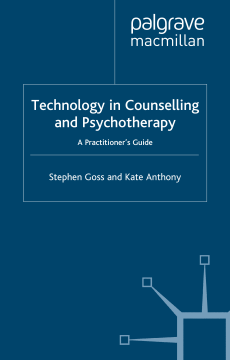
Additional Information
Book Details
Abstract
Over recent years information technology has become an increasingly important part of counselling and psychotherapy. This innovative and broad-ranging text, with contributions from internationally leading figures, provides an up-to-the-minute, precise and practical guide to the different ways in which technology can be used in therapeutic work, including e-mail and internet relay chat; telephone; video-link and stand-alone software packages. As well as discussing vital ethical, theoretical and practical considerations for practitioners, the authors look at the likely impact of these technologies on therapeutic relationships and the outcomes that can be expected. Technology's impact is explored from the perspectives of both therapists and clients, including individual therapy, groups, supervision and training, and supported by extensive case studies.
STEPHEN GOSS is Research Development Manager with the British Association for Counselling and Psychotherapy, Honorary Research Fellow with the University of Strathclyde and a qualified counsellor and supervisor. He is the lead author and editor of the recent BACP Guidelines for Online Counselling and Psychotherapy and his other publications include Evidence Based Counselling and Psychotherapy with Nancy Rowland (2000).
KATE ANTHONY runs onlinecounsellors.co.uk which provides consultancy services and training for counsellors using the internet. She is also a counsellor with Oxleas Health Trust and her previous publications include the BACP Guidelines for Online Counselling and Psychotherapy (with Stephen Goss et al.).
'This book is essential reading for practitioners, supervisors and tutors from many different therapeutic backgrounds working independently or in organisationl settings, whether on-line or face-to-face. Therapists, by their very nature, are explorers and this book provides exciting new territory.' - Rose-Marie Court, CPJ
'As a counsellor whose workplace is setting up an online service I have found it a very useful text, and one that managed to avoid too much usage of technological jargon. It discusses many of the ethical, theoretical and practical issues that surround working in media where the counsellor is not physically in the same room as the client and gives some very good examples of actual practice. I found it to be a very readable book that raised issues around an area that is both exciting and controvesial.' - Terry Hanley, Healthcare, Counselling and Psychotherapy
'For all of us who have wondered how to integrate technology into our practice, or worry about whether we should integrate technology into our practice, I find this book offers advice, information and case studies around these themes in a helpful and insightful way; exploiting not only advantages and disadvantages, but also clinical and ethical issues relevant to the utilisation of technology in counselling.' - Counselling Australia
'Technology in Counselling and Psychotherapy offers a solid contribution to the literature on how technology in three specific areas has been used in counselling and psychotherapy.' - counsellingresource.com
Table of Contents
| Section Title | Page | Action | Price |
|---|---|---|---|
| Contents | vii | ||
| List of screenshots | xi | ||
| Notes on the contributors | xii | ||
| Preface | xvii | ||
| Acknowledgements | xx | ||
| Introduction | 1 | ||
| 1. The use and role of technology in counselling and psychotherapy | 13 | ||
| Part I. Email and Internet Relay Chat | 37 | ||
| 2. Individual therapy online via email and Internet Relay Chat | 39 | ||
| 3. Conducting group therapy online | 59 | ||
| 4. The supervisory relationship online | 75 | ||
| Part II. Telephone and video links | 91 | ||
| 5. Telephone counselling and psychotherapy in practice | 93 | ||
| 6. Video counselling and psychotherapy in practice | 109 | ||
| 7. Video and telephone technology in supervision and supervision-in-training | 129 | ||
| Part III. Computerized therapy: stand-alone and practitioner-supported software | 141 | ||
| 8. Computer programs for psychotherapy | 143 | ||
| 9. The computer plays therapist: the challenges and opportunities of psychotherapeutic software | 165 | ||
| Conclusion | 195 | ||
| Index | 209 |
